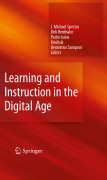
Learning and instruction in the digital age
Spector, J. Michael
Ifenthaler, Dirk
Isaias, Pedro
Sampson, Demetrios
Instruction tailored to the individual student, learning and teaching outsidethe limits of time and space—ideas that were once considered science fiction are now educational reality, with the prospect of an intelligent Web 3.0 not far distant. Alongside these innovations exists an emerging set of critical-thinking challenges, as Internet users create content and learners (and teachers)take increased responsibility in their work. Learning and Instruction in the Digital Age nimbly balances the technological and pedagogical aspects of theserapid changes, gathering papers from noted researchers on a wealth of topics relating to cognitive approaches to learning and teaching, mental models, online learning, communications, and innovative educational technologies, among them: Cognition and student-centered, Web-based learning, The progression of mental models throughout a course of instruction, Experiencing education with 3D virtual worlds, Expanding educational boundaries through multi-school collaboration, Adapting e-learning to different learning styles, The student blog as reflective diary. With its blend of timely ideas and forward thinking, Learningand Instruction in the Digital Age will enrich the work of researchers in educational psychology, educational technology, and cognitive science. Representsthe very latest work in the field where ICT, learning psychology, and instructional design intersect Expands on established interest of libraries and scholars Genuine multi-disciplinary approach to the field, with contributions from leading scholars INDICE: Preface.- Part I: Cognitive Approaches to Learning and Instruction. 1: Learning and Instruction in the Digital Age: Introduction. 2: Cognition and Student-Centered, Web-Based Learning. 3: Testing as Feedback to Inform Teaching. 4: Enhancing Learning from Informatics Texts.- Part II: Knowledge Representation and Mental Models. 5: Model-Based Knowledge Mapping. 6: Prototype forthe Knowledge Representation Supporting Inter-Institutional Knowledge Flow Analysis. 7: Progression of Mental Models Throughout a Course of Instruction. 8:The Qualitative Study of Contents Analysis and a Construction Method for e-Learning.- Part III: Technology-Facilitated Tools and Techniques. 9: VideoclipQuests as a New Setup for Learning. 10: Research on Computer-Supported Collaborative Learning in Trans-Disciplinary Groups. 11: Improving Teacher Performance Using an Enhanced Digital Video Reflection Technique. 12: Experiencing and Learning with 3D Virtual Worlds.- Part IV: Communications and Methods. 13: CARTE:An Observation Station to Regulate Activity in a Learning Context. 14: Acceptance of Model-Based Instruction Among Students in Spanish and Mathematics. 15:Communities of Learners: Extending the Boundaries of the Learning Experience Through Cross-Institutional Collaboration. 16: Supporting the Implementation of the Case Activities Using e-Learning Technologies. 17: Practices in Old Age ICT-Education.- Part V: Integrative Methods and Online Learning. 18: Cultural Features of e-Learning: A Euro-Asian Case Study. 19: Case Study on Student Blogs in a Blended Learning Course. 20: Self-Assessment: A Crucial Process in e-Training. 21: A Design Framework for an Online English Writing Course.-Chapter 22: Catering for Different Learning styles in e-Learning. 23: Learning and Instruction in the Digital Age: Epilogue.
- ISBN: 978-1-4419-1550-4
- Editorial: Springer
- Encuadernacion: Cartoné
- Páginas: 432
- Fecha Publicación: 01/02/2010
- Nº Volúmenes: 1
- Idioma: Inglés
